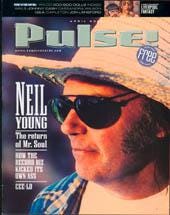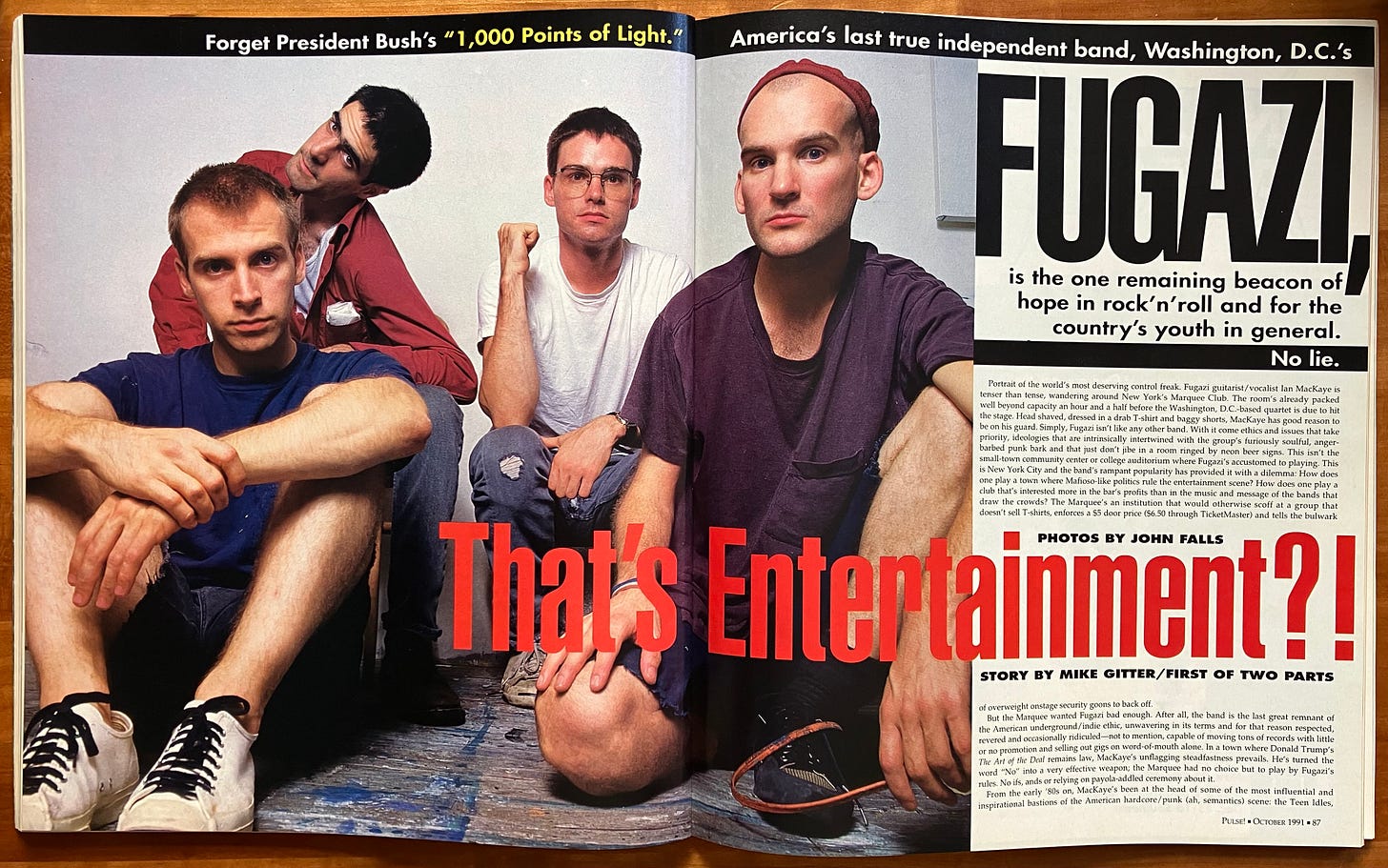An Appreciation of Pulse! Magazine
When the music lunatics at Tower Records ran the asylum, readers got one of the most honest, wide-ranging music magazines—for free.
In early November 2002, the staff at Pulse!, a free monthly magazine published by Tower Records since 1983, found out that their parent company was pulling the plug.
The late-September arrival of Betsy Burton, a “turnaround specialist” that the financially troubled Tower brought in to serve as its interim chief executive officer, set rumors of the magazine’s demise in motion. When Tower completed the sale of its retail operations in the Far East in October, the pressure seemed to lift—momentarily. Then, when Burton dismissed several longtime key executives a few weeks later, the future suddenly didn’t look that bright.
When the end finally did come, it wasn’t entirely unexpected. That didn’t make the transition less painful.
In mid-November, the magazine’s newly unemployed staffers were sorting through their offices and cubicles—taking down posters, tossing out piles of old magazines and papers, boxing up personal effects, and deciding what to do with advance copies of CDs slated for release in early 2003.
The mood seemed one of shocked disbelief more than anything else. By Wednesday, a couple of people had left already. Of those who remained, some hadn’t gotten around to serious packing and had instead spent their time sending emails and making phone calls. A security guard stopped by to remind people to turn in their keys by Friday. The phones kept ringing, but many of those calls came from subscribers who wanted the balance of their subscriptions back.
“We’re all out of jobs, and these people are worried about getting a refund for a few measly dollars?” local musician Chris Woodhouse asked rather sardonically. His day job was answering the phones at Pulse!. “Ri-i-ight.”
On the bright side, the people at Pulse! did get a little time to grieve and say goodbye. Too often in the corporate world, severed employees get half an hour to gather their things before security guards give them the bum’s rush off company property.
It was too easy to blame Tower for shuttering Pulse! However, any incoming CEO, hired to show no sentimental attachment to any part of the company and deputized to trim all excess expenditures, probably would do the same thing Burton did. This is not to argue the pros or cons of that decision.
Instead, Tower should be commended for publishing a music magazine for almost 20 years. When Mike Farrace, then a regional coordinator for Tower’s in-house advertising agency, approached Tower founder Russ Solomon with the idea for a free publication targeted toward habitual record buyers, Solomon—to his credit—gave it the green light. It was a novel idea, and it worked.
Of course, my opinion might be a little biased, because I worked at Pulse! as an editor and writer for 16 of the magazine’s 19 years.
Pulse! magazine’s long run dovetailed with what might be called the last golden age of the music business: the compact-disc era. The magazine appeared as a newsprint tabloid in March 1983, roughly a year or two before the CD began to replace the vinyl LP, with stories that began on the front cover. By the end of that first year, its covers featured full-color illustrations, but the insides still had a newspaper feel. This would evolve over time into a much slicker-looking magazine.
With the advent of the CD, record companies began to reissue their back catalogs. They also began merging with other labels, buying dormant record labels, and starting ambitious new record divisions. By the end of the 1980s, it seemed that labels thought there was no limit to how big the music business might get. That was fortuitous for Pulse! The labels needed to advertise all the new records they were dumping into the market. What better way than in a magazine that a national record store chain gave away?
Because it was free, some Tower customers who picked up Pulse! for the first time might have thought they were getting a “shopper” filled with puff pieces on major-label priority acts and glowing reviews of whatever was being advertised. Although some of those major-label priorities did make it into the magazine, more often than not, the stuff the magazine printed was there because somebody on the staff really believed in an act or in its new record.
Not everything was perfect. Editorial meetings that planned future issues occasionally devolved into horrible examples of internecine warfare, with complex horse trading going on behind the scenes (such as, OK, if you insist on forcing the issue with this flavor-of-the-week English band whose publicist has offered a junket to Stonehenge to half the staff and all of the freelancers, I’ll look the other way if we also run a piece on this semi-obscure loft-jazz legend). Most of the time, meetings were surprisingly civil. Considering the amount of musical ground the magazine tried to cover, that was remarkable.
Even though the first few years’ issues of Pulse! more closely resembled BAM, the now-defunct Northern California rock tabloid, Farrace started aiming at Rolling Stone pretty early on. At that time, Rolling Stone was arguably the best-edited pop-culture magazine on the market. It remained a benchmark. But, over time, Rolling Stone changed from a hardcore music rag into a lifestyle publication, with articles on celebrities and politics mixed in with a dwindling number of music features. And its music reportage had become rather stodgy—the editorial version of classic-rock radio programming.
From the beginning, Pulse! was much more eclectic. Instead of individual record reviews, which it switched to later, the magazine featured columnists in the early years who covered records according to genre; Farrace’s idea was to take a record store’s various sections and replicate them inside the magazine. So in addition to columns focusing on rock-pop, R&B, hip-hop, country, jazz, and blues, there were columns covering reggae, international and world-beat music, folk and bluegrass, reissues and jazz reissues, rock imports, gospel, children’s music, women’s music, comedy, spoken word and, later, electronica. And the magazine also covered classical and opera before it spun—or ghettoized—them off into another magazine called Classical Pulse! (For a time, there also was a magazine for Tower’s video stores called TVC, or Tower Video Collector.) What made Pulse! work was context—you could open an issue and read about the latest pop-music product and then flip the page and read about some grizzled blues veteran or avant-classical composer.
As a result, number of people gravitated to the magazine’s decidedly non-mainstream musical taste. Some people, like import columnist Paul Ashby or folk-music writer Larry King, already worked for Tower. Others worked as freelancers, including jazz writers Gene Santoro, Howard Mandel and Art Lange; new-age columnist (and former Tim Buckley guitarist) Lee Underwood; world-beat columnist j. poet; Memphis author Robert Gordon; country writers Michael McCall and Holly Gleason; and college professor (and jazz and gospel columnist) Michael Jarrett, and even Galaxie 500 member Damon Krukowski, who wrote about classical music. In addition to Farrace and myself, there were a number of other editors: Laurie MacIntosh, Suzanne Mikesell, Mara Wildfeuer, Barbarina Baker, Peter Melton, Bill Forman, Ned Hammad, Heather Willis, and Bob Levine, not to mention two of the finest aesthetes I’ve ever met: Marc Weidenbaum and Jason Verlinde.
Over time, and with a few exceptions, Farrace let the lunatics run the asylum. That and the location of the magazine’s headquarters—in a rather Spartan tilt-up industrial park in West Sacramento near the port and the UPS terminal, about as far from the music-business glamour centers of Manhattan or Hollywood as you can get—kept Pulse! from turning into the usual music-scene fish wrap.
But what really helped define the magazine was the attention it gave to independent record labels. Spend any time listening to a steady diet of major-label releases, and you’ll probably come to one of two conclusions: that Jennifer Lopez is God, and that it’s OK for celebrities to displace real musicians now that the technology exists to make that happen. If that realization isn’t acceptable, then you come to understand why it is dreadfully important that obscure, independent-label acts—the kind that you rarely if ever hear on radio—have an avenue for their music to reach the public. Nurturing the independents was an idea that Farrace brought from his days of working at Tower Records on Watt Avenue in the 1970s, when a record fanatic named Mike Koontz ran the store.
Unfortunately, as Farrace put it recently, “That idea of Tower no longer exists.”
So in 2002, Pulse! passed into history, too. Its December issue, the final one, featured Marc Weidenbaum’s cover story on Missy Elliot. After that? The official corporate announcement of its demise was curiously open-ended, intimating that it might be “revived” at some future date. Perhaps, but without any real connection to the original magazine, that would merely be an exercise in branding.
What should be noted is that Pulse! magazine put out 222 issues. That it often ran against the grain and championed music, popular and not so popular. That it developed a following for its eclectic vision, not only in this country but across the world. That it was a local success story that many locals had no idea was produced in Sacramento. And, most obviously, that it is missed.
Jackson Grifith worked at Tower Records stores (1977-1980, 1983-84) and as an editor at Tower's Pulse! magazine from 1984-2000.
Note: A different version of this piece originally appeared as “Flatliner Blues” in the Sacramento News & Review, November 21, 2002. Story is republished here with Grifith’s permission.








I loved that magazine when I worked at the store in the '80s and a decade later worked with cool Marc Weidenbaum on a few cover (Isaac Hayes, Gang Starr) stories. I wrote a piece earlier this year about the first NYC store. That place was paradise. https://wearethemutants.com/2023/04/12/on-4th-and-broadway-remembering-tower-records/
Thanks for the walk back in time. Going to Tower was always highly anticipated.